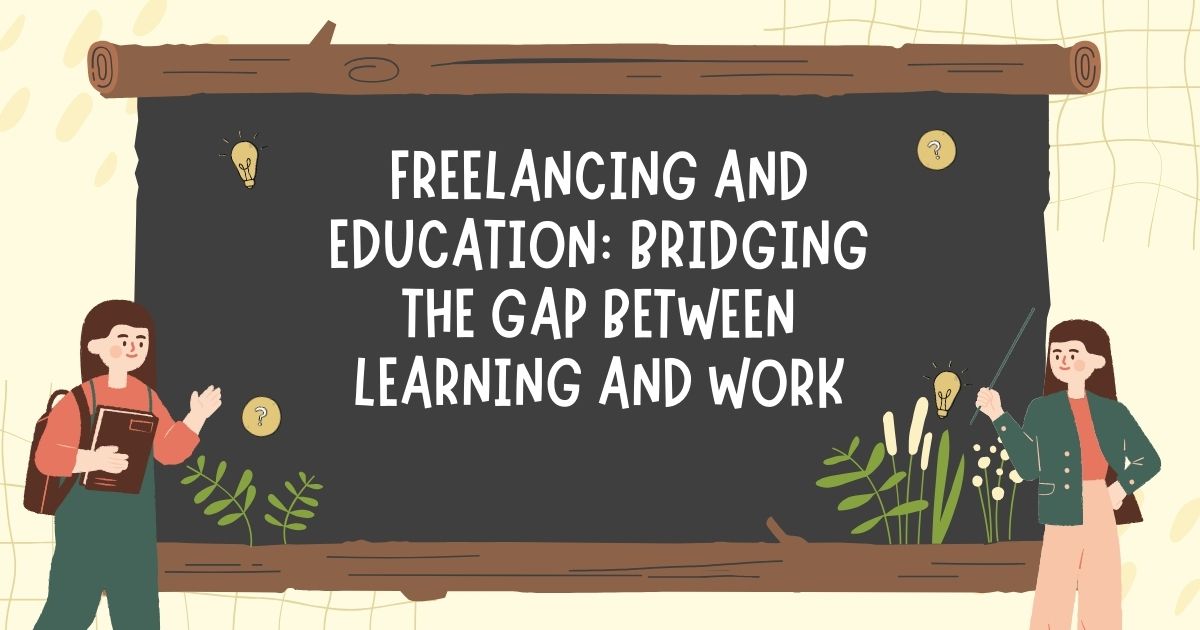Introduction
In the rapidly changing work environment, there is much pressure on bridging education and employment. One popular solution is freelancing. Freelancing can contribute to closing the skills gap and creating a smoother transition from learning to earning. In what way? Let’s look at the complicated relationship between freelance and education.

The Benefits of Freelancing for Students
Freelancing has too many upsides for students; it is a functional way to acquire useful experiences, develop various skills, and make money while still in college. This flexible work model allows adjusting hours complemented by academic responsibilities.
Curating an online portfolio through various freelance projects for students can be quite a strategic career move and helps them gain that competitive edge when they enter into the post-graduation job market.
This is why freelance jobs that are done from home, like writing, typing jobs, part-time work from home, or copywriting, do not just provide other income sources but also offer new routes to learning opportunities beyond the walls of typical classrooms.
Freelancing While Studying – Tips to Succeed
Being a student, planning and organizing your time properly is crucial in navigating the freelance environment as you study. It is important that you balance your studies and learn freelancing skills at the same time so that you move ahead towards success. Here are some tips to successfully balance academics and freelancing:
1] Prioritize Time Management
Make a timetable that outlines academic and freelancing tasks. It requires a balance of time to relax or engage in social activities.
2] Align Freelance Work with Studies
Opt for freelancing gigs like freelance typewriters or anything that matches your area of specialization. This alignment not only complements academic knowledge but also aids the formation of a professional network.
3] Value Your Work
Set reasonable prices for your services. Even though it may seem tempting to undervalue your work to attract clients, professional service is non-exhaustive, and paying a fair fee shows the value of what you have learned.
4] Be Ready To Learn
While you are learning and freelancing, it is must that you learn freelancing skills as well. There are various courses available online here you can learn and upgrade yourself to stay ahead of the others.
5] Network To Grow
To grow as a freelancer networking is important. LinkedIn can be a good source to network. Not only that, when you network there are chances that you might get in connection with someone who will be able to guide you and help you in your journey.
Understanding the Skills Gap
The modern division of labor faces an acute problem- the evident gap between skills. This gap arises from the mismatch between demands on skills by employers versus what potential candidates in the job market possess. Technological progress and employment changes have further widened this gap when many jobs today demand sophisticated technical skills not fully acquired through formal academic settings.
How To Bridge the Gap Between the Two?
When you are trying to bridge the gap between the two, you need to understand about educational aspect as well. Below are some of the tips and tricks that might help you:
1] Emphasize Soft Skills
Although technical skills are important, soft skills such as communication and problem resolution also play a significant role. Introducing soft skills training in curricula equips the students with the complete needs of the work industry.
2] Focus on Practical Experience
Practical experience is usually lacking in classroom training. Providing internships and co-op placements allows students to gain practical knowledge demanded by employers.
3] Collaboration Between Employers and Educational Institutions
It takes collaborative efforts to bridge the skills gap. Employers can share their comments on the necessary skills that will assist educational establishments in tailoring their programs. Internships and co-op programs promote collaboration that benefits both parties.
4] Lifelong Learning
The job market is changing constantl. So, it’s important that you are ready to learn new skills and are open to challenges. Continuing education programs offered by educational institutions can also help ensure job seekers are abreast of industry happenings.
Conclusion
In conclusion, it is clear that freelancing can be seen as a vibrant alternative to solve the dilemma of studying and working simultaneously. There is, of course, the skill gap, which can be a challenge. Still, with soft skill emphasis and practical experience along with promoting collaboration, we will create a workforce able to facilitate the needs of any given modern job. It is not enough to write jobs from home or take part-time typing jobs; the fact remains that a successful freelancing journey involves cultivating a mindset of lifelong learning and adaptability.
Start your growth freelancing career today with ZoopUp. Adapt to the future of work with certainty!
FAQs
Q1: Can freelancing help students bridge the skills gap and effortlessly transition from learning to earning?
Yes, freelancing can generate true experience and make the transition easier. Copy typing freelance jobs and other small freelancing projects enable students to put into practice what they have learned in real-life situations. It is also flexible enough to enable people to juggle work and study obligations. With the abilities that businesses need, these writing jobs from home without investment provide them the opportunity to continue their own education as well.
Q2: How can students be able to combine their freelancing activity with their studies in a more efficient way?
Students should select freelancing tasks that align with their major or interests. It might make sense if they are studying marketing and social media management. Writers are a strong suit in content production. This gives people opportunities for professional training and networking with professionals in the sector. The work also helps them further their education and prepares them for life after college.
Q3: How does partnership assist in making ends meet regarding the gap in skills between schools and market demands for work?
Collaboration is critical. Schools and businesses should work together to ensure that the curriculums align with occupational requirements. Those companies that provide feedback or internships are mutually beneficial for students as well as companies as they’re able to gain valuable skills while identifying forthcoming employees.




















0 Comments